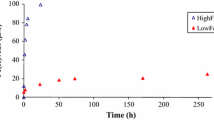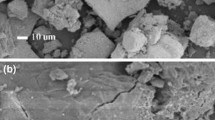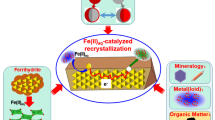Abstract
In this work, we study the abiotic re-mineralization of ferrihydrite under reducing conditions, obtained by adding zero-valent iron (ZVI) to a suspension of ferrihydrite particles. Under similar conditions, the system (ferrihydrite and ZVI) proceeded along two different transformation pathways differentiated by whether a magnetic stirrer or an overhead stirrer was used for mixing. X-ray diffraction characterization of the solid products showed that magnetite was the sole product of ferrihydrite transformation when a magnetic stirrer was used, whereas both goethite and magnetite were formed when an overhead stirrer was used. The system also behaved differently in terms of transformation kinetics and amount of magnetite formed. The quantification of magnetite generated was performed using a procedure developed in this study. The role of four mechanisms was investigated to explain these observed differences, namely—(1) presence/absence of high local Fe2+ concentrations, (2) mechanical abrasion, (3) presence/absence of a magnetic field, and (4) presence/absence of a crystalline ZVI surface. Ferrous ions are expected to be concentrated near the magnetic bead on the magnetic stirrer as opposed to a more dispersed distribution with the overhead stirrer. This mechanistic study concluded that the presence of high local Fe2+ concentrations in the system leads to magnetite formation and the absence of the same leads to mixed goethite/magnetite or magnetite-free systems. These findings have significant implications for the mobilization of arsenic from iron (III) hydroxides as the conditions move from oxidizing to reducing, such as often occurs in engineered landfills and natural carbon-rich sediments.








Similar content being viewed by others
REFERENCES
Benner S, Hansel C, Wielinga B, Barber T, Fendorf S (2002) Reductive dissolution and biomineralization of iron hydroxide under dynamic flow conditions. Environ Sci Technol 36:1705–1711
Burnol A, Charlet L (2010) Fe(II)-Fe(III)-bearing phases as a mineralogical control on the heterogeneity of arsenic in Southeast Asian groundwater. Environ Sci Technol 44:7541–7547
Burnol A, Garrido F, Baranger P, Joulian C, Dictor M, Bodenan F et al (2007) Decoupling of arsenic and iron release from ferrihydrite suspension under reducing conditions: a biogeochemical model. Geochem Trans. doi:10.1186/1467-4866-8-12
Burton ED, Johnston SG, Bush RT (2011) Microbial sulfidogenesis in ferrihydrite-rich environments: effects on iron mineralogy and arsenic mobility. Geochim Cosmochim Acta 75:3072–3087
Clesceri LS, Greenberg AE, Eaton AD (1998) Standard Methods for the Examination of Water and Wastewater. APHA, Washington DC
Coker VS, Gault AG, Pearce CI, van der Laan G, Telling ND, Charnock JM et al (2006) XAS and XMCD evidence for species-dependent partitioning of arsenic during microbial reduction of ferrihydrite to magnetite. Environ Sci Technol 40:7745–7750
Cornell R (1988) The influence of some divalent-cations on the transformation of ferrihydrite to more crystalline products. Clay Miner 23:329–332
Cornell RM, Schwertmann U (2003) The Iron Oxides: Structure, Properties, Reactions. Occurences and Uses, Wiley VCH
Cortinas I, Sierra-Alvarez R, Field JA (2008) Biologically mediated mobilization of arsenic from granular ferric hydroxide in anaerobic columns fed landfill leachate. Biotechnol Bioeng 101:1205–1213
Das S, Hendry MJ, Essilfie-Dughan J (2011a) Effects of adsorbed arsenate on the rate of transformation of 2-line ferrihydrite at pH 10. Environ Sci Technol 45:5557–5563
Das D, Hendry MJ, Essilfie-Dughan J (2011b) Transformation of two-line ferrihydrite to goethite and hematite as a function of pH and temperature. Environ Sci Technol 45:268–275
Datta S, Mailloux B, Jung HB, Hoque MA, Stute M, Ahmed KM, Zheng Y (2009) Redox trapping of arsenic during groundwater discharge in sediments from the Meghna riverbank in Bangladesh. Proc Natl Acad Sci USA 106:16930–16935
Dixit S, Hering J (2003) Comparison of arsenic(V) and arsenic(III) sorption onto iron oxide minerals: implications for arsenic mobility. Environ Sci Technol 37:4182–4189
Ghosh A, Mukiibi M, Saez AE, Ela WP (2006) Leaching of arsenic from granular ferric hydroxide residuals under mature landfill conditions. Environ Sci Technol 40:6070–6075
Giles DE, Mohapatra M, Issa TB, Anand S, Singh P (2011) Iron and aluminum based adsorption strategies for removing arsenic from water. J Environ Manage 92:3011–3022
Halim MA, Majumder RK, Nessa SA, Oda K, Hiroshiro Y, Jinno K (2010) Arsenic in shallow aquifer in the eastern region of Bangladesh: insights from principal component analysis of groundwater compositions. Environ Monit Assess 161:453–472
Hansel C, Benner S, Neiss J, Dohnalkova A, Kukkadapu R, Fendorf S (2003) Secondary mineralization pathways induced by dissimilatory iron reduction of ferrihydrite under advective flow. Geochim Cosmochim Acta 67:2977–2992
Hansel C, Benner S, Fendorf S (2005) Competing Fe(II)-induced mineralization pathways of ferrihydrite. Environ Sci Technol 39:7147–7153
Herbel M, Fendorf S (2006) Biogeochemical processes controlling the speciation and transport of arsenic within iron coated sands. Chem Geol 228:16–32
Horneman A, Van Geen A, Kent D, Mathe P, Zheng Y, Dhar R et al (2004) Decoupling of As and Fe release to Bangladesh groundwater under reducing conditions. Part 1: evidence from sediment profiles. Geochim Cosmochim Acta 68:3459–3473
Islam F, Gault A, Boothman C, Polya D, Charnock J, Chatterjee D et al (2004) Role of metal-reducing bacteria in arsenic release from Bengal delta sediments. Nature 430:68–71
Jekel M, Amy JL (2006) Chapter 11: Arsenic removal during drinking water treatment. In: Newcombe G and Dixon D (eds) Interface Science in Drinking Water Treatment, 1st edn. Elsevier
Jing C, Liu S, Meng X (2008) Arsenic remobilization in water treatment adsorbents under reducing conditions: part I incubation study. Sci Total Environ 389:188–194
Kocar BD, Herbel MJ, Tufano KJ, Fendorf S (2006) Contrasting effects of dissimilatory iron(III) and arsenic(V) reduction on arsenic retention and transport. Environ Sci Technol 40:6715–6721
Latta DE, Gorski CA, Scherer MM (2012) Influence of Fe(2 +)-catalyzed iron oxide recrystallization on metal cycling. Biochem Soc Trans 40:1191–1197
Liu H, Wei Y, Sun Y, Wei W (2005) Dependence of the mechanism of phase transformation of Fe(III) hydroxide on pH. Colloids Surf A Physicochem Eng Asp 252:201–205
Liu H, Guo H, Li P, Wei Y (2008a) The transformation of ferrihydrite in the presence of trace Fe(II): the effect of the anionic media. J Solid State Chem 181:2666–2671
Liu S, Jing C, Meng X (2008b) Arsenic re-mobilization in water treatment adsorbents, under reducing conditions: part II. XAS and modeling study. Sci Total Environ 392:137–144
Maity JP, Nath B, Chen CY, Bhattacharya P, Sracek O, Bundschuh J, Kar S, Thunvik R, Chatterjee D, Ahmed KM, Jacks G, Mukherjee AB, Jean JS (2011) Arsenic-enriched groundwaters of India, Bangladesh and Taiwan–comparison of hydrochemical characteristics and mobility constraints. J Environ Sci Health A Tox Hazard Subst Environ Eng 46:1163–1176
Mamindy-Pajany Y, Hurel C, Marmier N, Romeo M (2011) Arsenic (V) adsorption from aqueous solution onto goethite, hematite, magnetite and zero-valent iron: effects of pH, concentration and reversibility. Desalination 281:93–99
Manceau A (2009) Evaluation of the structural model for ferrihydrite derived from real-space modelling of high-energy X-ray diffraction data. Clay Miner 44:19–34
Manceau A (2011) Critical evaluation of the revised akdalaite model for ferrihydrite. Am Mineral 96:521–533
Manceau A (2012) Comment on “direct observation of tetrahedrally coordinated Fe(III) in ferrihydrite”. Environ Sci Technol 46:6882–6884
Masue-Slowey Y, Ying SC, Kocar BD, Pallud CE, Fendorf S (2013) Dependence of arsenic fate and transport on biogeochemical heterogeneity arising from the physical structure of soils and sediments. J Environ Qual 42:1119–1129
Morin G, Wang Y, Ona-Nguema G, Juillot F, Calas G, Menguy N et al (2009) EXAFS and HRTEM evidence for As(III)-containing surface precipitates on nanocrystalline magnetite: implications for As sequestration. Langmuir 25:9119–9128
Mukiibi M, Ela WP, Sáez AE (2008) Effect of ferrous iron on arsenate sorption to amorphous ferric hydroxide. Ann NY Acad Sci 1140:335–345
Müller K, Ciminelli VS, Dantas MS, Willscher S (2010) A comparative study of As(III) and As(V) in aqueous solutions and adsorbed on iron oxy-hydroxides by Raman spectroscopy. Water Res 44:5660–5672
Neumann A, Kaegi R, Voegelin A, Hussam A, Munir AK, Hug SJ (2013) Arsenic removal with composite iron matrix filters in Bangladesh: a field and laboratory study. Environ Sci Technol 47:4544–4754
Nguyen KP, Itoi R (2009) Source and release mechanism of arsenic in aquifers of the Mekong delta Vietnam. J Contam Hydrol 103:58–69
O’Loughlin EJ, Gorski CA, Scherer MM, Boyanov MI, Kemner KM (2010) Effects of oxyanions, natural organic matter, and bacterial cell numbers on the bioreduction of lepidocrocite (gamma-FeOOH) and the formation of secondary mineralization products. Environ Sci Technol 44:4570–4576
Omoregie EO, Couture RM, Van Cappellen P, Corkhill CL, Charnock JM, Polya DA, Vaughan D, Vanbroekhoven K, Lloyd JR (2013) Arsenic bioremediation by biogenic iron oxides and sulfides. Appl Environ Microbiol 79:4325–4335
Pallud C, Masue-Slowey Y, Fendorf S (2010) Aggregate-scale spatial heterogeneity in reductive transformation of ferrihydrite resulting from coupled biogeochemical and physical processes. Geochim Cosmochim Acta 74:2811–2825
Pedersen H, Postma D, Jakobsen R, Larsen O (2005) Fast transformation of iron oxyhydroxides by the catalytic action of aqueous Fe(II). Geochim Cosmochim Acta 69:3967–3977
Pedersen HD, Postma D, Jakobsen R (2006) Release of arsenic associated with the reduction and transformation of iron oxides. Geochim Cosmochim Acta 70:4116–4129
Rancourt DG, Meunier J- (2008) Constraints on structural models of ferrihydrite as a nanocrystalline material. Am Mineral 93:1412–1417
Reza AH, Jean JS, Lee MK, Liu CC, Bundschuh J, Yang HJ, Lee JF, Lee YC (2010) Implications of organic matter on arsenic mobilization into groundwater: evidence from northwestern (Chapai-Nawabganj), central (Manikganj) and southeastern (Chandpur) Bangladesh. Water Res 44:5556–5574
Root RA, Fathordoobadi S, Alday F, Ela W, Chorover J (2013) Microscale speciation of arsenic and iron in ferric-based sorbents subjected to simulated landfill conditions. Environ Sci Technol 47:12992–13000
Schwertmann U, Cornell RM (1991) Iron Oxides in the Laboratory: Preparation and Characterization. VCH, New York, pp 111–113
Shan H, Ma T, Wang Y, Zhao J, Han H, Deng Y, He X, Dong Y (2013) A cost-effective system for in situ geological arsenic adsorption from groundwater. J Contam Hydrol 154:1–9
Smedley P, Kinniburgh D (2002) A review of the source, behaviour and distribution of arsenic in natural waters. Appl Geochem 17:517–568
Stuckman MY, Lenhart JJ, Walker HW (2011) Abiotic properties of landfill leachate controlling arsenic release from drinking water adsorbents. Water Res 45:4782–4792
Tronc E, Belleville P, Jolivet J, Livage J (1992) Transformation of ferric hydroxide into spinel by Fe(II) adsorption. Langmuir 8:313–319
Tufano KJ, Fendorf S (2008) Confounding impacts of iron reduction on arsenic retention. Environ Sci Technol 42:4777–4783
Tufano KJ, Benner SG, Mayer KU, Marcus MA, Nico PS, Fendorf S (2009) Aggregate-scale heterogeneity in iron (Hydr)oxide reductive transformations. Vadose Zone J 8:1004–1012
van Geen A, Zheng Y, Cheng Z, Aziz Z, Horneman A, Dhar R et al (2006) A transect of groundwater and sediment properties in Araihazar, Bangladesh: further evidence of decoupling between As and Fe mobilization. Chem Geol 228:85–96
Wang Y, Morin G, Ona-Nguema G, Menguy N, Juillot F, Aubry E et al (2008) Arsenite sorption at the magnetite-water interface during aqueous precipitation of magnetite: eXAFS evidence for a new arsenite surface complex. Geochim Cosmochim Acta 72:2573–2586
Wang Y, Morin G, Ona-Nguema G, Juillot F, Calas G, Brown GE Jr (2011) Distinctive arsenic(V) trapping modes by magnetite nanoparticles induced by different sorption processes. Environ Sci Technol 45:7258–7266
Wang Y, Sikora S, Kim H, Dubey B, Townsend T (2012) Mobilization of iron and arsenic from soil by construction and demolition debris landfill leachate. Waste Manag 32:925–932
Yang L, Steefel CI, Marcus MA, Bargar JR (2010) Kinetics of Fe(II)-catalyzed transformation of 6-line ferrihydrite under anaerobic flow conditions. Environ Sci Technol 44:5469–5475
Yee N, Shaw S, Benning L, Nguyen T (2006) The rate of ferrihydrite transformation to goethite via the Fe(II) pathway. Am Mineral 91:92–96
Zegeye A, Mustin C, Jorand F (2010) Bacterial and iron oxide aggregates mediate secondary iron mineral formation: green rust versus magnetite. Geobiology 8:209–222
Acknowledgments
This work was supported by the National Institute of Environmental Health Sciences (NIEHS) Grant No. P42 ES04940. The authors declare that they have no conflict of interest. This paper’s contents are solely the responsibility of the authors and do not necessarily represent the official views of NIEHS. The authors wish to thank Phil Anderson of the University Spectroscopic Imaging Facility at the University of Arizona for performing the XRD analyses. The authors also wish to acknowledge the work of an undergraduate student, I-Tso Chen, who assisted with sample preparation for XRD analysis, and microwave digestions for aqueous iron analysis.
Author information
Authors and Affiliations
Corresponding author
Rights and permissions
About this article
Cite this article
Raghav, M., Sáez, A.E. & Ela, W.P. Understanding abiotic ferrihydrite re-mineralization by ferrous ions. Int. J. Environ. Sci. Technol. 12, 1945–1956 (2015). https://doi.org/10.1007/s13762-014-0599-7
Received:
Revised:
Accepted:
Published:
Issue Date:
DOI: https://doi.org/10.1007/s13762-014-0599-7




